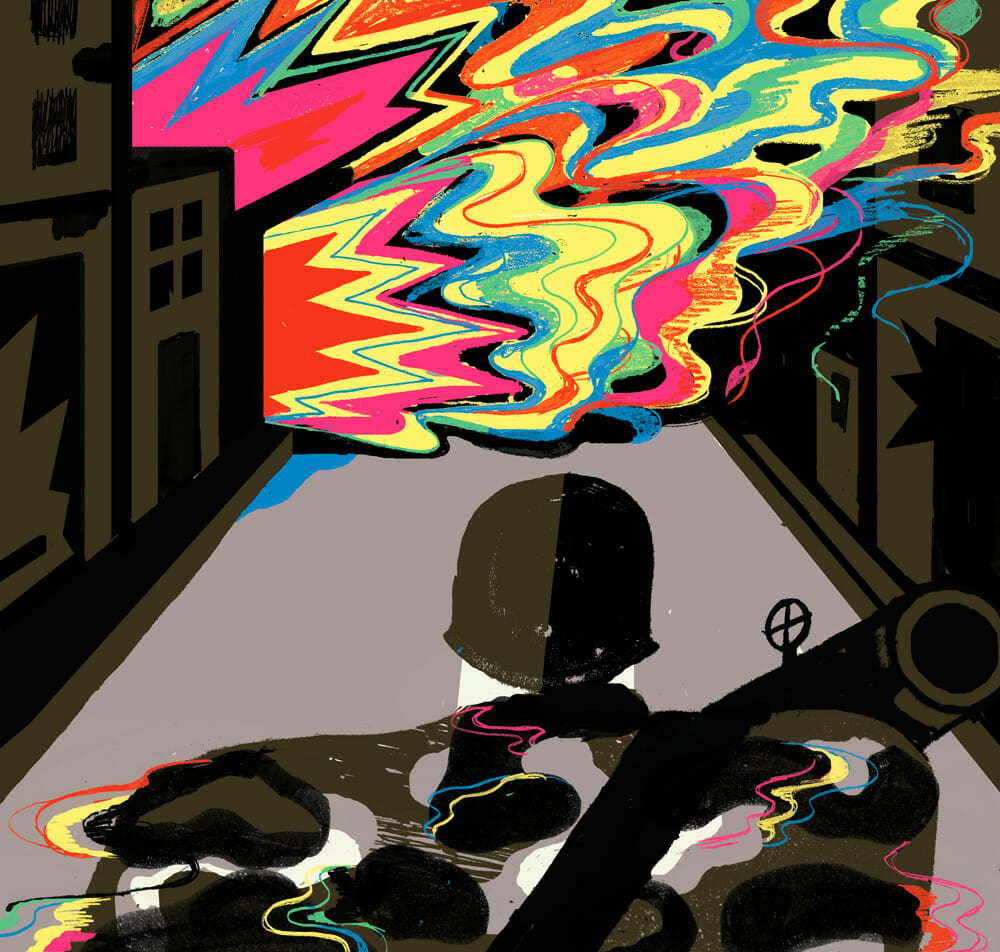I Dream of Content-Trash
With the Dream Machine, Instagram-capitalism becomes the stuff of nightmares Jason Arias
Jason Arias o
r
d
F
a
c
t
o
r
y
They come dressed in their post-brunch best. They come in packs. They come to be photographed.
They flock to the sanitized byways of Williamsburg for the Dream Machine, a new and wildly Instagrammable “experience” that compels users to let their imaginations “run wild” as they explore nine surreal rooms—of clouds, bubbles, ball pits, cotton candy—inspired by dreams. Soon they will number in the thousands, this well-groomed crop of spendthrift pathfinders, but today, in the first week of the Dream Machine’s two-month lifespan, the crowd is smaller, almost intimate.
The Dream Machine is an Instagram-thing that charges higher ticket prices than the Whitney, MoMA, or the Louvre.
Reports vary as to what exactly the Dream Machine is. Is it an “experience,” “museum,” “cultural space,” “marketplace,” or “playground?” Unblinking in the Machine’s lobby of prematurely wilting palm trees, in the cool glow of its neon sign, the crowd shifts—waiting, scrolling, anticipating how they will contort themselves photogenically in the tableaux to come. For this is a content hustle of the highest order: an Instagram-thing that charges higher ticket prices than the Whitney, MoMA, or the Louvre.
What does the attendee, the user of the Dream Machine get in return? Quite literally, a dream of someone else’s design. Inside the Machine’s guts, the globally integrated spectacle of our ceaseless stream of content-trash launches its assault on the final frontier: the idea of human sleep. But it’s not just our dreams. As a result of this advancing bacchanal of VSCO filters, of data mining, of likes and shares and sponsored posts, “the primary self-narration of one’s life shifts in its fundamental composition,” writes Jonathan Crary in 24/7: Late Capitalism and the Ends of Sleep. “Instead of a formulaic sequence of places and events,” Crary continues, “the main thread of one’s life story is now the electronic commodities and media services through which all experience has been filtered, recorded, or constructed.” This idiot pageant designed specifically for Instagram, in other words, this plasticized dreamworld, is more and more the very stuff of our lives, or at least the stories we tell ourselves.
And now this: the silvery velvet curtain is drawn back, and we are commanded to “have a good dream.”
?Let the adventures begin . . . . . . . . . #giaryan #thedreammachine #dreammachine #interactiveexhibit #brooklyn #brooklynstreetstyle #brooklynbabies #williamsburg #neonlights #sillouette #toddler #13monthsold #babymodel #toddlermodel #springerspaniel #nyadventures #brooklynadventures #inthedreammachine
The Dream Machine, product of experiential ad agency castaways Paige Solomon and Gary Johnson, is merely the latest example of Instagram’s incursion into every cranny of lived experienced in its bid to become a, if not the, preferred apparatus for mediating and engendering reality—not only for the app’s eight hundred million rank-and-file users but for everyone everywhere.
Though not an agent of Instagram itself, the Dream Machine nonetheless operates spontaneously on its behalf. In this respect, it joins a celebrated if curiously unmemorable list of non-space exhibitions—of “rooms” designed to be Instagrammed—that includes the pioneering “Rain Room” (53,731 posts) by Random International and the hyper-exportable “infinity mirror rooms” of Yayoi Kusama (15,030 posts). All of these are spectacular works in a conventional sense: they are divorced entirely from geographical context, and they provide for the user both optimal lighting and a backdrop for self-portraiture. They serve no additional purpose except for branding and ticket sales.
More

War Games
By Scott BeauchampRecently this compulsion to design works and spaces for the iPhone-eye achieved a new stage of ambition with the opening of the Museum of Ice Cream. A candy-colored hell of colossal popsicles, ice cream sandwich swings, scooper seesaws, and sprinkle pools—all awash in the corporate patronage of Tinder, American Express, and Dove chocolate—the Museum of Ice Cream promises to actualize one’s wildest flights of child fancy, so long as these flights are serviceable to sponsors. In its original New York iteration, all three hundred thousand tickets sold within five days of opening. When it later moved to San Francisco, the initial batch of tickets sold out in less than ninety minutes. Even Queen Bey and Blue Ivy deemed the renowned sprinkle pool worthy of a Boomerang—while wearing matching $5,400 Dolce & Gabbana dresses.
Now welcoming selfie fiends in sunny Miami, the Museum of Ice Cream (147,047 posts) reveals the evanescence of a pre-Instagrammed reality. “[W]hatever remaining pockets of everyday life are not directed toward quantitative or acquisitive ends, or cannot be adapted to telematic participation,” argues Crary, “tend to deteriorate in esteem and desirability.” Into this melt of non-enthusiasm for a less mediated life—and no doubt mesmerized by the Museum of Ice Cream’s reported six million dollars in revenue—arrives the Dream Machine, ready to unburden its visitors of the capacity to imagine other worlds.
?got my head stuck in the clouds ?
Implicit in the terms and conditions of the Dream Machine’s user experience is (contra the ad copy) imaginative acquiescence. The Machine calls out and we respond, “Ah, yes, this is what a dream looks like.” Nor is there ample room to “run wild” as advertised—among the clouds or in any subsequent chamber of the Machine. (But there is plenty of time and space for posing.) The Machine, in other words, restricts the machinegoer and does the dreaming on his behalf; to echo Guy Debord, the user’s dreams are no longer his own but rather the dreams of someone else who represents them back to him.
This much is made plain by the images already posted with the Dream Machine’s hashtags (#dreammachine or #inthedreammachine), which confirm the extreme paucity of “dreamed” experience. The cumulus clouds and other backdrops do the conceptual heavy lifting, indicating to the viewer that the Instagram portrait’s subject is, in fact, someone who dreams not of sex, class war, or unintended public nudity, but of anodyne clouds and bubble rooms (with the latter perhaps sponsored, or at least attended, by little bitty sample cups of Hal’s New York seltzer water advertised by a “dream technician” as “just like Willy Wonka’s Fizzy Lifting Drink!”).
But herein lurks an irony: by immersing yourself in a temporary reality of populated meme-crap, you are purchasing a reprieve from the Bad News World. “Dreams are an escape,” claims founder Johnson in an interview with amNewYork, and “with the world we’re living in and the feeds that inundate us with bad news, we don’t really [get a break]. We wanted to have a space that is a respite.” In practice, however, the Machine both assaults and abets this idea of the apparatus as a break—a relief from life and labor. It is, for one, just as overcrowded and saturated with sweat-air as the city outside—perhaps more so. Further, the user is not absolved from labor by any means—its evidence merely eludes the frame. They work diligently and without shame in the staging of themselves and their companions for photographs. (Almost no one travels to the Dream Machine alone). On the other hand, a frolic through these vistas requires not an ounce of critical engagement from the user, which is all to say that the Machine is exactly like the “real world”—only worse.
Meanwhile, Crary adds, our own dreams become nothing more than the “mere self-regulatory adjustment of the sensory overload of waking life,” and so “most people remain incognizant of and uninterested in their own periodic dream production, which might superficially seem like a series of pitifully drab or deficient versions of mass-media productions of what purport to be dreams.” On this score, the Dream Machine and its designers are giddy; they’ve gleefully raided not only the short “curatorial history” of the spectacle exhibition (for example, Kusama’s “infinity mirror rooms”) for the bulk of their gimmicks, they’ve also deployed the baseline clichés of dream imagery: supernatural fauna, puffy clouds, razzle-dazzle rainbows, secret passageways. The coiffed and grinning masses lean into this world, with great enthusiasm, for perhaps these exact reasons—it is all childlike, childish, and thoughtless. The Machine’s nine rooms possess no secrets and ask no questions.
The Dream Machine does, however, issue directives. In the third room, an ethereal laundromat illuminated in soft pinks and blues, another neon sign advises: “Drop Off and Selfie Service.” Users comply happily, posing with electric pink cotton candy, spun and served gratis from atop a washing machine. “We did design this with the phone in mind,” says Solomon, without a hint of self-awareness.
?Sunday funday exploring #dreammachine . . . . . . . . . . #adventure #spring2018 #instapic #selfiesunday #guy #bluesteel #instagood
And, anyway, it shows; beyond the limits of the frame, the Machine is decidedly un-dreamlike—the rooms swarm with bodies awaiting their turn, the air is hot, the floor is sticky, and upon closer inspection, a lot of this shit is from Ikea.
A quick survey of the work composed under such conditions and posted under the sign of the #dreammachine (91,929 posts—a number likely much lower if you disregard the noise of luxury cars, the German rock band Tokio Hotel, now on tour promoting their latest album Dream Machine, etc.) reveals an unsurprising uniformity: a limited range of poses, all captioned without imagination (see, for instance, “It Was All A Dream #yaaas #queen #sundayfunday #art #artinstallation #installation #fashion #fashiondesigner #fashiondesign #cottoncandy #prettyinpink #modernart #interactiveart #interactive #laundry #contemporaryart #contemporary #lights #design #instagood #inthedreammachine #dreammachine #williamsburg #wilyburg #bk #brooklyn #nyc”), most of them given a post-production tint in VSCO or equivalent app, with the true star students clearly sporting grainy filters aping the look of film.
Dreams should be fundamentally incompatible with social media-capitalism’s ceaseless imperative of movement, stream, and exchange, of accruing likes.
Of course, this aesthetic conformity has certain advantages for semiotic capitalism; namely, it congeals our dreams and imaginations (and their representations) into a loogie of sameness, of the sort that users love to spread around.
But dreams—and the requisite state of eyes-closed rest, of reverie, of stillness—should be fundamentally incompatible with social media-capitalism’s ceaseless imperative of movement, stream, and exchange, of accruing likes. And yet, the dominant condition in the Machine is not rest or imagination but waiting, for extended periods of time, in between trashscapes. “We have a lot of people dreaming right now,” the technicians explain to the line in the lobby that later gives way to a line snaking through half of the Machine, backed up behind the particularly popular sets—the ball pit (36,000 balls!) at one point commands a fifteen-minute line—and indicating the proprietors’ goal of filling the Machine to its legal capacity at every moment. The lag evokes the sudden, unexpected loss of service: the thumb scroll tugs, the wheel spins, the screen remains blank.
Still, the glut of images here produced—selfies in the company of clouds, bubbles, and neon lights—will soon join its plastic balls, wilted palms, and decorative dryers in the ever-expanding junkyards of e-waste and corporeal garbage when the Dream Machine packs up at the end of May. That is, unless the Machine’s architects have their way: pending the success of this first iteration, they’ll be able to take the Machine on a tour of the country, literalizing our nation’s diminishing dreams eleven hours a day, four days a week, until the next pop-up arrives.